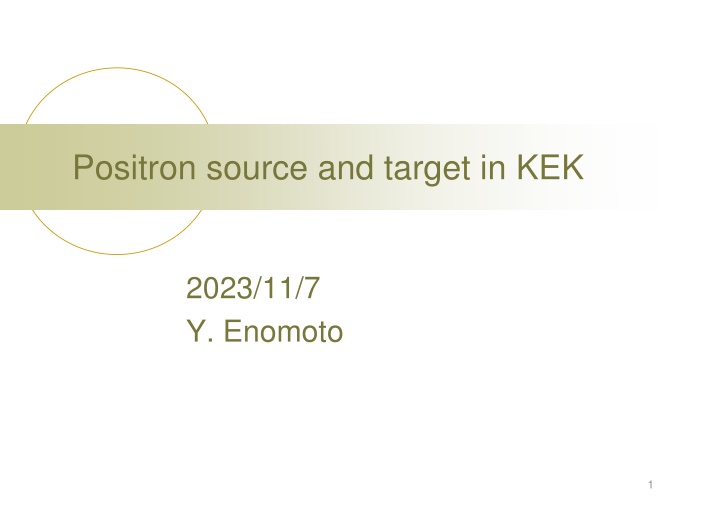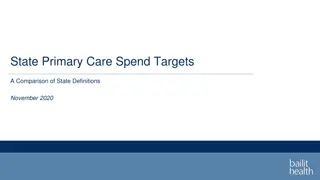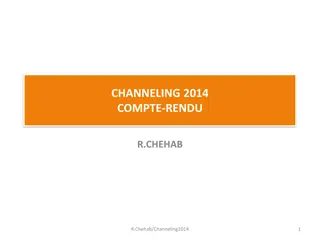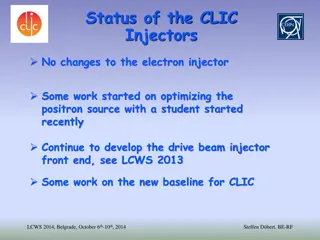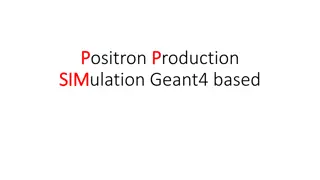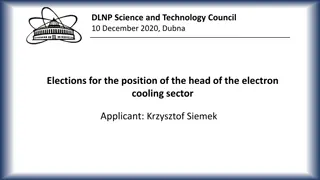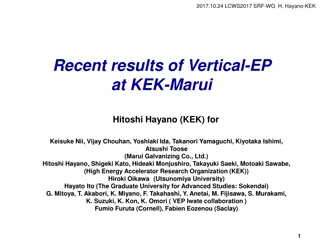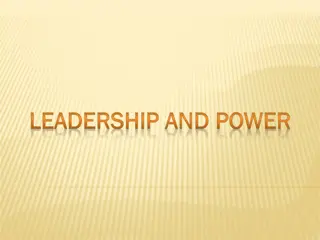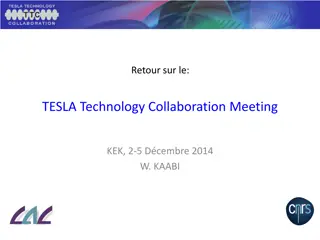Overview of Positron Sources and High-Power Targets at KEK
Comparison of the positron source at KEK, from the TRISTAN era to current SuperKEKB operations, along with details on high-power targets used in various experiments. The discussion covers the development of positron sources for the ILC, the significance of SuperKEKB, and the challenges associated with maintaining and utilizing high-power targets. Additionally, insights are provided on the design and functionality of the positron source for SuperKEKB, key specifications of the SuperKEKB target, and considerations for particle sources related to the acceleration of high-quality beams.
Download Presentation

Please find below an Image/Link to download the presentation.
The content on the website is provided AS IS for your information and personal use only. It may not be sold, licensed, or shared on other websites without obtaining consent from the author.If you encounter any issues during the download, it is possible that the publisher has removed the file from their server.
You are allowed to download the files provided on this website for personal or commercial use, subject to the condition that they are used lawfully. All files are the property of their respective owners.
The content on the website is provided AS IS for your information and personal use only. It may not be sold, licensed, or shared on other websites without obtaining consent from the author.
E N D
Presentation Transcript
Positron source and target in KEK 2023/11/7 Y. Enomoto 1
KEK and positron TRISTAN From TRISTAN to ILC KEK LINAC has keep providing positron beam to e+e-collider experiment since 1980s. Positron source for SuperKEKB is world s most intense positron source in operation. We play an important role to develop future positron source for ILC. SuperKEKB KEKB 2
Comparison of high-power targets in Japan e+ e+ n Neutrinos Hadrons RIBF Institute KEK (SuperKEKB) ILC (e-driven) J-PARC J-PARC J-PARC J-PARC RIKEN Primary particle e- e- p p p p C~U Target material W W C Hg C Au Be, W Energy [GeV] 3 3 3.5 3 30 30 0.345/u Charge/pulse [nC] 13300 13300 52900 16470 CW 10 2 3.7 66 Repetition [Hz] 50 100 / 300 25 25 0.47 0.19 CW (1puA) Beam Power [kW] 3 74 1000 1000 750 95 82 Beam size x y[mm] Thickness [mm] 0.5 0.5 2 2 3.5 3.5 37 17 4.2 4.2 2.5 1.0 0.42 0.42 14 16 20 2000 909 ~mm 66 (6 11) Deposited power [kW] 0.5 18.8 3.1 480 20 7.4 18 PEDD [J/g] 27.5 33.6 20 1.1 190 Slow extraction CW Cooling Water Water Radiation Water He Water Water structure Fixed Rotating Rotating Liquid Fixed Fixed Rotating beam power deposited power 50 1000 40 Power (kW) 30 500 20 10 0 0 3 RIBF SKEKB ILC n H RIBF SKEKB ILC n H
Particle sources and positron source secondary particle source Primary particle source Accelerator Neutron source Muon source Neutrino source Electron source Ion source High quality beam for acceleration Stand alone test is possible No radiational, thermal requirement Positron source source Low beam quality is acceptable Need high power primary beam Severe radiational, thermal requirement Positron source is installed in the middle of accelerator Collection and acceleration of secondary particles need high power primary beam for full test Usually impossible before construction 4
Positron source for SuperKEKB Originally developed by SLAC Almost all the other positron sources follows this design Surrounded by solenoid limited space Need UHV <10-6Pa FC = pulsed coil (20 kV, 12 kA) installed close to target (2mm) 5
SuperKEKB target W 4 L14 HIP to Cu block for cooling Hole for electron Beam power 3 kW (3 GeV 10 nC 2 bunch 50 Hz) Deposition ~ 0.7 kW PEDD : 27.5 J/g 6
temperature Y. Morikawa 20 ms Pulsed heating every 20 ms by beam Amplitude ~ 200 7
stress Y. Morikawa Thermal stress by pulsed beam High at Cu-W contact surface Care must be taken to fatigue 50 Hz = 4 106/day Beam heat peak (140 MPa) Beam heat peak (30 MPa) Caused by difference of thermal expansion coefficient and edge geometry (580MPa) Caused by difference of thermal expansion coefficient and edge geometry (610MPa) 8
Withstanding heat load Melting point Unavoidable Limit Single pulse destruction Thermal stress exceed material yield strength Short pulse beam instantaneous temperature rise Embrittlement by recrystallization W-Re alloy shows better value Difficult to obtain large size Advanced W alloys are one of research field JPS Conf. Proc. 28, 031002 (2020) Fatigue limit by repetitive thermal load by pulsed beam ~3700 K (456 J/g) Melting point Single pulse destruction ~2160 K (250 J/g)* embrittlement by recrystallization ~1500 K (161 J/g) ~870 K (77 J/g) fatigue Value in varies design of target. Here target of SuperKEKB is assumed for reference. *thermal stress reach 1 GPa 9
From SuperKEKB to ILC 0.5 Based on SuperKEKB Big jump from SuperKEKB 3 x SLC in beam power (74 kW) 4 x SuperKEKB in capture efficiency past present future 0.45 ILC e-driven 0.4 0.35 Ne+/Ne-/GeV 0.3 High efficiency CLIC 0.25 0.2 0.15 SuperKEKB FCCee 0.1 BEPC DAFNE VEPP-5 0.05 CEPC KEKB SLC ILC undulator 0 0 20 40 60 80 e- beam power (kW) High power 10
Latest 3D model for ILC positron source Rotating target RF cavity solenoid Flux concentrator 11
Rotating target in Japan e+ Hadrons RIBF Institute ILC (e-driven) J-PARC J-PARC RIKEN Primary particle e- p p C~U Target material W C Au or W Be, W Repetition [Hz] 100 / 300 25 0.19 CW (1puA) Beam Power [kW] 74 1000 150 82 (design) Deposited power [kW] 18.8 3.1 11 18 (design) PEDD [J/g] 33.6 20 Slow extraction CW status Prototype In operation Prototype In operation Cooling Water Radiation He Water Thanks to J-PARC Muon: Matoba, Makimura J-PARC hadron: Sawada, Takahashi, Watanabe RIKEN RIBF: Yoshida, Yanagisawa 12
To do Water cooled UHV compatible rotating mechanism Robust W-Cu connection RF cavity after the target ~a few 10 kW heat load from shower Flux concentrator compatible with rotating target Exchange mechanism of highly activated materials in accelerator tunnel Not in special target area Deep underground (~100 m) and limited space Grant from MEXT FY2023 ~ FY2027 Development started 2022/Q4 13
5 years-plan 2022 2023 2024 2025 2026 2027 FY year 2023 2024 2025 2026 2027 Quarter Q4 Q1 Q2 Q3 Q4 Q1 Q2 Q3 Q4 Q1 Q2 Q3 Q4 Q1 Q2 Q3 Q4 Q1 Q2 Q3 Q4 Q1 Test bench High power test bench W-Cu connection Target unit 1stunit 2ndunit 3rdunit FC base 1stunit 2ndunit magnet Solenoid + ST Power supply Chamber, vacuum, support Acc. Structure Dummy 1stunit 2ndunit FC power supply RF power supply Design Manufacuring test 14
Summary Say hello to the high-power target community from positron group Different requirement and limitation from proton machine Most of the technologies are still useful for us Requirements of the ILC, linear collider, are very high We started development for ILC recently Details about rotating target next talk 16
Bunch structure M. Kuriki, OHO seminar 2021 Create positron for 66 ms Store them in the DR for 199.3 ms Extract them to main linac for 0.7 ms 20 pulse / train 66 bunch / pulse 1320 bunch / train Repetition 5 Hz 66 . train FC must keep field variation below the requirement to keep bunch-by-bunch charge variation Minimum current pulse width is about 500 ns 3.3 ms 20 = 66 ms pulse 18
